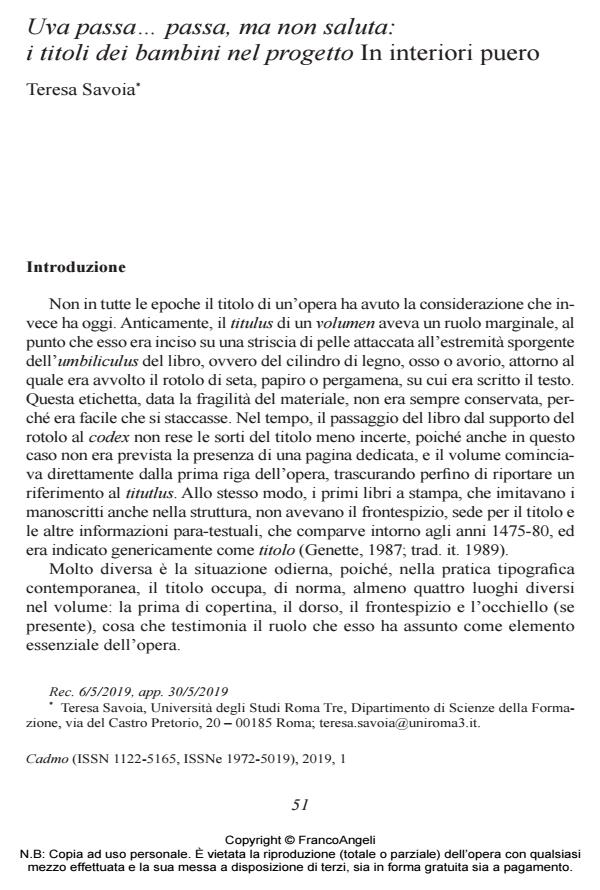Uva passa.. passa, ma non saluta: students’ titles in the project In interiori puero
Journal title CADMO
Author/s Teresa Savoia
Publishing Year 2019 Issue 2019/1
Language Italian Pages 13 P. 51-63 File size 208 KB
DOI 10.3280/CAD2019-001005
DOI is like a bar code for intellectual property: to have more infomation
click here
Below, you can see the article first page
If you want to buy this article in PDF format, you can do it, following the instructions to buy download credits

FrancoAngeli is member of Publishers International Linking Association, Inc (PILA), a not-for-profit association which run the CrossRef service enabling links to and from online scholarly content.
The following contribution introduces a study on the titles of the texts produced by the students for the project In interiori puero. Titles are by themselves meaningful elements in the written production, as they reveal aspects concerning the cognitive processes of their writers. Specifically in this project, their choice implies an even more complex task, as they represent the synthesis between two different semiotic systems: the image proposed to the students as a stimulus for their productions and their written texts. A framework was defined for the analysis of the corpus in order to describe them under different perspective, both structural (Genette, 1987; Di Fazio, 1984) and semantic (Eco, 1980; Adorno, 1979), and define how a title can be considered as good or not. Finally, a chronological analysis, conducted under these perspectives, allowed the possibility to verify a possible evolution of the titles in time and check the fruitfulness of the practice of hand writing.
Keywords: Title, wrting processes, semiotic system, titrelogie, hand writing.
- Adorno, T. (1974), Note per la letteratura. Torino: Einaudi, 1979.
- Agrusti, F. (2016), “Evidenze lessicometriche del corpus Nulla dies sine linea”, in B. Vertecchi (a cura di), I bambini e la scrittura. Milano: FrancoAngeli.
- Agrusti, G. (2016), “Le parole per scrivere”, in B. Vertecchi (a cura di), I bambini e la scrittura. Milano: FrancoAngeli.
- André, P. (2007), La Bible et l’Occident. Paris: Bayard.
- Angelini C. (a cura di) (2017), Imparare a scrivere a mano. Roma: Epsylon.
- Barthes, R. (1965), Eléments de sémiologie. Paris: Gonthier.
- Barthes, R. (1973), Le Plaisir du texte. Paris: Gonthier.
- Bolasco, S. (2005), “Statistica testuale e text mining: alcuni paradigmi applicativi”, Quaderni di statistica, 7, pp. 17-53.
- Di Fazio Alberti, M. (1984), Il titolo e la funzione paraletteraria. Torino: ERI.
- Eco, U. (1977), Apocalittici e integrati. Milano: Bompiani.
- Eco, U. (1979), Lector in fabula. Milano: Bompiani.
- Eco, U. (1980), Il nome della rosa. Milano: Bompiani.
- Frye, N. (1957), Anatomy of Criticism: Four Essays. Princeton: Princeton University Press.
- Genette, G. (1972), Figures III. Paris: Seuil; trad. it. Figure III. Discorso del racconto. Torino: Einaudi, 1976.
- Genette, G. (1987), Seuils. Paris: Edition du Seuil; trad. it. Soglie. Torino: Einaudi, 1989.
- Marchese, A. (1983), L’officina del racconto. Milano: Mondadori.
- Nardi, E. (1994), “L’analogia: aspetti logici e retorici”, in B. Vertecchi, M. La Torre, E. Nardi (a cura di), Valutazione analogica e istruzione individualizzata. Firenze: La Nuova Italia.
- Nardi, E. (2003), Nella rete del testo. Unità didattiche per lo sviluppo della capacità di comprensione della lettura. Milano: FrancoAngeli.
- Scholes, R., Kellogg, R. (1966), The Nature of Narrative. New York: Oxford University Press.
- Šklovskij, V.B. (1917), O teori prozy; trad. it. Sulla teoria della prosa. Torino: Einaudi, 1981.
- Vertecchi, B., Angelini, C., Poce, A., Nardi, E., Agrusti, F., Harb, N. (2017), “La mente, le azioni, i segni”, Cadmo. Giornale italiano di Pedagogia sperimentale – An International Journal of Educational Research, 25 (1), pp. 101-118.
Teresa Savoia, Uva passa.. passa, ma non saluta: i titoli dei bambini nel progetto In interiori puero in "CADMO" 1/2019, pp 51-63, DOI: 10.3280/CAD2019-001005